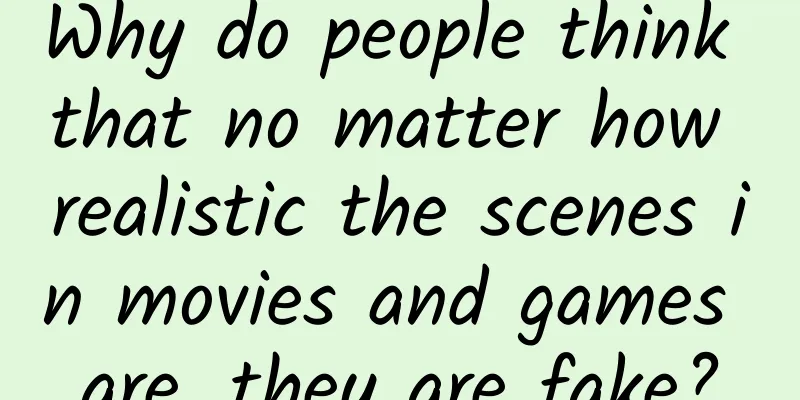Why do people think that no matter how realistic the scenes in movies and games are, they are fake?

|
Audit expert: Zheng Yuanpan, professor at Zhengzhou University of Light Industry With the development of film, television and technology, we can present many imaginary scenes in a visual form to the public. For example, superheroes in movies travel through unknown universes; adventures in fantasy worlds in game CGs; singers singing in the clouds and interacting with flying birds in performances, etc. Intellectually, we obviously know that none of this is real, but why are these lifelike scenes so realistic, even down to the finest hair? A fictional city in the game CG Source: Screenshot of an online game This makes us wonder, what is real and what is unreal? Some time ago, there was a very popular short video on the short video platform titled "Why do you think this is fake?". In the video, the guy stood in front of a stream that looked fake. In order to prove the authenticity of his background, he threw a bucket backwards. The splashing water and the action of picking up the bucket confirmed the authenticity of the background. This video has also been spoofed by many netizens, with different backgrounds Source: A video website In the later stage of "Special Effects Brother Studio" at Bilibili, he only retained the character's movements and used computer synthesis technology to rebuild a fake background that was indistinguishable from the real thing. He also revealed step by step how the realistic virtual background was synthesized, which included background construction, motion capture, multi-layer synthesis and other technologies. On one side is the questionable real background, and on the other side is the convincing fake background. Faced with this situation, we can't help but ask: How do the human eye and brain distinguish the true and false images they see? And how does imaging technology influence and guide this intuition? Let's take a look today. In fact, scientists have also taken many detours in the process of studying the human eye's ability to distinguish between truth and falsehood. For a long time, scientists believed that if humans want to judge whether a person or an object is real or fake, they need to pay attention to many details and make comparisons to draw conclusions. However, in an article published in the journal Nature Communications, researchers from the United States have found that humans can instantly judge the realism of a group of things. Realistic 3D scene source: hippopx This comes from a visual mechanism called "overall realism perception", which allows people to judge the reality of a scene within 0.25 seconds. In an experiment led by researchers at the University of California, Berkeley, the researchers selected 68 healthy adults with normal vision and randomly showed them a group of pictures including ice cream, guinea pigs in shirts, hockey players, and plastic cars carrying toy passengers. The subjects were able to accurately evaluate the realism of the pictures by intuition after reading them. Source: hippopx In addition to simply judging truth and falsehood through common sense, how does modern technology blur the boundaries between scenes reconstructed using virtual technology? The three-dimensional vision we feel comes from the dual perception of psychology and physiology. From the traditional 2D large screen to the light field (a function used to describe the amount of light passing through each point and each direction in space) display, technology has developed step by step, from the beginning through affine (in geometry, a linear transformation of a vector space followed by a translation, transforming it into another vector space), occlusion, lighting and shadow, texture, and prior knowledge (knowledge prior to experience) five aspects of psychological visual cues, allowing the brain to produce pseudo 3D vision, to providing physiological visual information including binocular parallax, motion parallax and focal blur, and complementing psychological visual information to create a visually infinitely realistic scene. Source: pexels So how are the 3D images we see achieved? To understand how virtual characters and scenery are integrated with real characters on a screen, we have to mention the mainstream of today's film imaging industry - green screen movies. Green screen , as the name implies, is a green curtain. First, film the actors' performance in front of the green background curtain; then use the computer to create the scene as needed; then use the "one-click keying" function to separate the actors from the green screen; finally, add the actors to the synthesized real scene or animation. An example of using a green screen to synthesize images. The right side shows the synthesized image. Source: Wikipedia Why do people choose green as the curtain? The first reason is that the image acquisition of the digital camera's photosensitive chip follows the RGB three primary color principle , and the signal is collected in the form of red, green, green and blue, making the camera most sensitive to green. Using green as a curtain can present more details. In addition, the complementary color of human skin color is green , and the computer can clearly identify the difference between skin color and green. In addition, in general, people's clothes and hair accessories rarely appear green, and the use of green screen will also reduce expenses. In addition to the green screen method of using color difference to cut out images, there are many other keying techniques, such as brightness keying or frame keying. After all, the animation we see is the animation effect achieved by the continuous playback of static film. At this time, we only need to modify the film frame by frame to achieve the effect of changing the picture. In addition to the screen, holographic imaging technology can also be used to project the holographic image of an object onto a transparent medium to create a 3D stereoscopic perception, and assisted by lighting and sound and light effects such as wind, rain, thunder and lightning to create a realistic scene. This technology is widely used in amusement parks, cinemas and musicals. Head-mounted device source: hippopx From the earliest black-and-white silent movies to today's fully immersive head-mounted devices, humans have been challenging the limits of imagination and trying to break down the barriers between virtuality and reality. The truth that "seeing is believing" is being reshaped with the development of technology; vision, as the most important channel for information transmission in the "post-Z era", is being given more and more meaning. How will the virtual and real world be intertwined in the future? Let us look forward to it together. |
<<: Can quitting sugar make us more beautiful and younger?
>>: How did the ancients celebrate the start of winter? They even sacrificed cattle!
Recommend
The mobile phone "lifespan" ranking list is released, Huawei is not in the top three, the top spot is expected
With the popularity of smart phones, more and mor...
Operating Douyin Enterprise Account, these 7 tips are worth learning
With its powerful ability to bring goods, Douyin ...
What’s the secret to “brand placement” that goes viral?
There is a saying in the branding industry that “...
Can load-bearing walls be demolished? Demolishing the wrong wall can have serious consequences!
Recently, a resident in a residential area in Har...
China Passenger Car Association & Anluqin: The new four modernizations index of passenger cars in December 2021 is 69.4
The Passenger Car New Four Modernizations Index, ...
The first set of photography system courses for clothing people, a compulsory course for mobile clothing photography, just look at Brother Chao to learn clothing photography
The first set of photography system courses for c...
Interpreting Mango TV's unique advancement path from three key words
Mango TV has always been regarded by industry ins...
This molecular mechanism allows plants to "control their mouths"
Produced by: Science Popularization China Author:...
Can primary school students save Nokia?
Unless a groundbreaking system emerges, it will b...
In addition to selling traffic, there are many other ways to monetize new media.
Last Friday, the fashion giant "Rebecca'...
How to play the second type of e-commerce information flow advertising!
When the Internet becomes a traditional industry,...
Changan Mazda MAZDA EZ-6 officially starts pre-sale with a pre-sale price of RMB 160,000 to RMB 200,000!
On September 28, Changan Mazda MAZDA EZ-6 (herein...
Hard to guard against! How realistic can AI scams be?
Digital life, online communication, electronic co...
Pay attention! Should you drink a cup of coffee in the morning or in the afternoon?
A cup of coffee a day seems to be the standard fo...
Will the “Snow Country” come?
On March 20, 2023, the last assessment product of...
![Tu Mi Character Design Issue 2 2021 [Good quality with courseware]](/upload/images/67cbfd8927968.webp)








